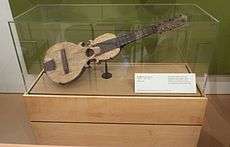Danza
Danza is a musical genre that originated in Ponce, a city in southern Puerto Rico.[1] It is a popular turn-of-the-twentieth-century ballroom dance genre slightly similar to the waltz.[2] Both the danza and its cousin the contradanza are sequence dances, performed to a pattern, usually of squares, to music that was instrumental. Neither the contradanza nor the danza were sung genres; this is a contrast to, for example, the habanera, which was a sung genre. There is some dispute as to whether the danza was in any sense a different dance from the contradanza, or whether it was just a simplification of the name.[3] Through the first part of the 19th century the dance and its music became steadily more creolized. The music and the dance is creolized because composers were consciously trying to integrate African and European ideas because many of the people themselves were creoles, that is, born in the Caribbean; accepting their islands as their true and only homeland.
| Music of Puerto Rico | |
|---|---|
 A (c. 1900 - 1915) Puerto Rican Cuatro | |
| General topics | |
| Related articles | |
| Genres | |
| Nationalistic and patriotic songs | |
| National anthem | La Borinqueña |
| Regional music | |
| |
Some well-known composers of danzas are Manuel Gregorio Tavárez,[4] "The Father of Puerto Rican Danza",[5] and Juan Morel Campos, considered by many to have raised the genre to its highest level.[6] Others are Cuban Ignacio Cervantes, and Curaçaoan Jan Gerard Palm.
Danza in Puerto Rico
Danza is a form of music that can be varied in its expression. The Puerto Rican national anthem, La Borinqueña, was originally a danza that was later altered to fit a more anthem-like style. Danzas can be either romantic or festive. Romantic danzas have four sections, beginning with an eight-measure paseo followed by three themes of sixteen measures each. The third theme typically includes a solo by the bombardino (baritone horn) and, often, a return to the first theme or a coda at the end. Festive danzas are free-form, with the only rules being an introduction and a swift rhythm.[7]
The first part of the romantic danza, the paseo, had 8 measures of music without a fixed rhythm (a snare drumroll may be played as background), when the couples circled the room elegantly, giving the lady the opportunity to display her beauty. The second part, called the merengue, grew from the original 16 measures to 34, in 1854. Here the couples held each other in a proper stance and executed turns that looked very much like a waltz.[7]
While the origins of the danza are murky, it probably arose around 1840 as a sort of reaction against the highly codified contradanza and, according to Cuban sources, was strongly influenced by Cuban immigrants and their habanera music. The first danzas were immature, youthful songs condemned by the authorities, who occasionally tried ineffectively to ban the genre.
In Puerto Rico, the genre continued evolving until it was taken up by the young pianist Manuel Gregorio Tavárez, who had just arrived from his studies in Paris, and took it to a new artistic level. His disciple, Juan Morel Campos, adopted it also and developed it further to its maximum expression, composing more than 300 danzas, most of them masterpieces of an exquisite beauty. The danza that evolved was inspired mostly by women and romance and their titles reflected that change.[7]
References
- Semana de la Danza. Travel & Sports: Puerto Rico. Retrieved May 7, 2010.
- Celebrations in Ponce. Tina Cohen and Ron Bernthal. Off the Beaten Path:Puerto Rico, a Guide to Unique Places. Fifth Edition: 2007. Page 90. Retrieved 8 December 2013.
- Léon, Argeliers. 1974. "De la contradanza al danzón". In Fernández, María Antonia (ed) Bailes populares cubanos. La Habana
- "Manuel Gregorio Tavárez" Archived 2013-06-23 at the Wayback Machine. Puerto Rico Encyclopedia
- "Manuel Gregorio Tavárez" The Home of Puerto Rican Danza
- "Juan Morel Campos" Archived 2011-07-28 at the Wayback Machine Puerto Rico Encyclopedia. Retrieved May 7, 2010.
- La Danza
Further reading
- Díaz Díaz, Edgardo. 2008. “Danza antillana, conjuntos militares, nacionalismo musical e identidad dominicana: retomando los pasos perdidos del merengue.” Latin American Music Review 29(2): 229–259.
- Díaz Diaz, Edgardo, and Peter Manuel. “Puerto Rico: The Rise and Fall of the Danza as National Music”. In Creolizing Contradance in the Caribbean, edited by Peter Manuel. Philadelphia: Temple University Press, 2009.
- Halman, Johannes and Robert Rojer (2008). Jan Gerard Palm (1831-1906) Music scores: waltzes, mazurkas, danzas, tumbas, polkas, marches, fantasies, serenades, a galop and music composed for services in the Synagogue and the Lodge. Amsterdam: Broekmans & Van Poppel.
- Malavet Vega, Pedro. Historia de la canción popular en Puerto Rico (1493-1898). San Juan, 1992.
- Manuel, Peter, with Kenneth Bilby and Michael Largey. Caribbean Currents: Caribbean Music from Rumba to Reggae (2nd edition). Temple University Press, 2006|ISBN 1-59213-463-7
- Manuel, Peter, "Puerto Rican Music and Cultural Identity: Creative Appropriation of Cuban Sources from Danza to Salsa," Ethnomusicology 3/2, Spring/Summer 1994, pp. 249–80.